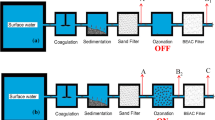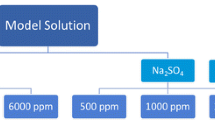Abstract
For effective wastewater reclamation and water recovery, the treatment of natural and effluent organic matters (NOM and EfOM), toxic anions, and micropollutants was considered in this work. Two different NOM (humic acid of the Suwannee River, and NOM of US and Youngsan River, Korea), and one EfOM from the Damyang wastewater treatment plant, Korea, were selected for investigating the removal efficiencies of tight nanofiltration (NF) and ultrafiltration (UF) membranes with different properties. Nitrate, bromate, and perchlorate were selected as target toxic anions due to their well known high toxicities. Tri-(2-chloroethyl)-phosphate (TCEP), oxybenzone, and caffeine, due to their different K ow and pK a values, were selected as target micropollutants. As expected, the NF membranes provided high removal efficiencies in terms of all the tested contaminants, and the UF membrane provided fairly high removal efficiencies for anions (except for nitrate) and the relatively hydrophobic micropollutant, oxybenzon. Through the wetlands, nitrate was successfully removed. Therefore, a fair process of combining membranes with an engineered wetland could be proposed for sustainable wastewater reclamation and optimum control of contaminats.
Similar content being viewed by others
References
Yang H, Abbaspour K C. Analysis of wastewater reuse potential in Bei**g. Desalination, 2007, 212(1–3): 238–250
Fattaa D, Anayiotou S. MEDAWARE project for wastewater reuse in the Mediterranean countries: An innovative compact biological wastewater treatment system for promoting wastewater reclamation in Cyprus. Desalination, 2007, 211: 34–47
Yim S K, Ahn W Y, Kim G T, Koh G W, Cho J, Kim S H. Pilotscale evaluation of an integrated membrane system for domestic wastewater reuse on islands. Desalination, 2007, 208(1-3), 113–124
Nakada N, Tanishima T, Shinohara H, Kiri K, Takada H. Pharmaceutical chemicals and endocrine disrupters in municipal wastewater in Tokyo and their removal during activated sludge treatment. Water Research, 2006, 40: 3297–3303
Nakada N, Shinohara H, Murata A, Kiri K, Managaki S, Sato N, Takada H. Removal of selected pharmaceuticals and personal care products (PPCPs) and endocrine-disrupter chemicals (EDCs) during sand filtration and ozonation at a municipal sewage treatment plant. Water Research, 2007, 41(19): 4373–4382
Kim T H, Jang M, Park J K. Bifunctionalized mesoporous molecular sieve for perchlorate removal. Microporous and Mesoporous Materials, 2008, 108(1–3): 22–28
Zularisam A W, Ismail A F, Salim M R, Sakinah M, Hiroaki O. Fabrication, fouling and foulant analyses of asymmetric polysulfone (PSF) ultrafiltration membrane fouled with natural organic matter (NOM) source waters. Journal of Membrane Science, 2007, 299: 97–113
Lee S, Lee C H. Effect of membrane properties and pretreatment on flux and NOM rejection in surface water nanofiltration. Separation and Purification Technology, 2007, 56: 1–8
Huang WJ, Cheng Y L. Effect of characteristics of activated carbon on removal of bromate. Separation and Purification Technology, 2008, 59(1): 101–107
Ghafari S, Hasan M, Aroua M K. Bio-electrochemical removal of nitrate from water and wastewater-A review. Bioresource Technology, 2008, 99(10): 3965–3974
Fries E, Puttmann W. Occurrence of organophosphate esters in surface water and ground water in Germany. Journal of Environmental Monitoring, 2001, 3: 621–626
Gokulakrishnan S, Chandraraj K, Gummadi S N. Microbial and enzymatic methods for the removal of caffeine. Enzyme and Microbial Technology, 2005, 37: 225–232
Park N, Kim J H, Cho J. Organic matter, anion, and metal wastewater treatment in Damyang surface flow constructed wetlands in Korea, Ecological Engineering, 2008, 32(1): 68–71
Lee S, Quyet N, Lee E, Kim S, Lee S, Jung Y D, Choi S H, Cho J. Efficient removals of tris(2-chloroethyl) phosphate (TCEP) and perchlorate using NF membrane filtrations. Desalination, 2008, 221 (1–3): 234–237
Shim Y, Lee H J, Lee S, Moon S H, Cho J. Effects of natural organic matter and ionic species on membrane surface charge. Environmental Science & Technology, 2002, 36: 3864–3871
Author information
Authors and Affiliations
Corresponding author
Rights and permissions
About this article
Cite this article
Sarp, S., Lee, S., Park, N. et al. Controlling various contaminants in wastewater effluent through membranes and engineered wetland. Front. Environ. Sci. Eng. China 3, 98–105 (2009). https://doi.org/10.1007/s11783-009-0006-7
Received:
Accepted:
Published:
Issue Date:
DOI: https://doi.org/10.1007/s11783-009-0006-7




